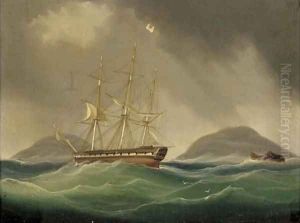William John Huggin Paintings
William John Huggin was an English marine painter whose works are known for their accuracy and attention to detail. Born in 1781, Huggin established himself in the tradition of maritime art, which was a significant genre in British art, especially during the period of the Napoleonic Wars and the subsequent years of British naval supremacy.
Huggin's career as a marine artist began in the early 19th century, a time when there was a high demand for maritime paintings that celebrated and documented Britain's naval power and commercial interests. His works often depicted ships and naval battles, capturing the dynamic and perilous nature of life at sea. Unlike some of his contemporaries, Huggin was not a sailor or a naval officer, but he developed a keen eye for the technical details of ships and the various aspects of seafaring life.
Throughout his career, Huggin's paintings were appreciated for their precision and the quality of his marine subjects. He paid great attention to the rigging, the build of the ships, and the way they interacted with the water, which resonated with patrons who had maritime connections or who were simply admirers of the sea. His clientele included naval officers, shipowners, and merchants who desired accurate representations of their ships or the vessels they were associated with.
William John Huggin lived and worked during a period that saw the rise of several prominent British marine artists, such as J.M.W. Turner and John Constable, who were his contemporaries. Although Huggin may not have achieved the same level of fame as these artists, his work was nonetheless an important part of the marine art scene of his time.
Huggin's death in 1845 marked the end of a career that contributed to the rich tapestry of British maritime history. His paintings remain as a testament to the skill and dedication of artists who documented the era's ships and seafaring endeavors. Today, William John Huggin's works can be found in various art collections, museums, and galleries, where they continue to be appreciated for their historical value and artistic merit.
